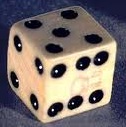Probability and Statistics > Probability Index > Probability problems
Probability Problems Overview.
If you’re taking a class in basic probability, right now you’re probably feeling utterly confused with the rules of probability. After all, there are lots. When do add? When to multiply? When to use combinations? Ugh. I remember when I was learning probability and even after I passed the class I still struggled with the heads and tails of figuring out when to use what rule. Here’s a summary of common situations which will show you how to solve probability problems using the right technique.
The types of probability problems shown here are simple events, like the odds of choosing something or winning something. Later on in probability, you’ll be coming across probability distributions like the binomial distribution and the normal distribution. You’ll usually know you’re solving a probability distribution problem by keywords like “normally distributed” or “fits a binomial distribution.” If that’s the case, you’ll want to check out the probability index for more articles on probability problems that involve distributions.
Click on the description below that describes the type of probability problem you have:

You want to know the probability of a certain event happening.
You want to know the probability of a certain dice roll.
You want to know the probability of picking from a deck of cards.
Probability Problems about Events.
Finding the probability of a simple event happening is fairly straightforward: add the probabilities together. For example, if you have a 10% chance of winning $10 and a 25% chance of winning $20 then your overall odds of winning something is 10% + 25% = 35%. This only works for mutually exclusive events (events that cannot happen at the same time).
Dice rolling probability problems.
To solve dice rolling problems, you could have one dice, or you could have three dice. The probability will change depending on how many dice you are rolling and what numbers you want to pick. The easiest way to solve these types of probability problems is to write out all the possible dice combinations (that’s called writing a sample space). A very simple example, if you want to know the probability of rolling a double with two die, your sample space would be:
[1][1], [1][2], [1][3], [1][4], [1][5], [1][6],
[2][1], [2][2], [2][3], [2][4],[2][5], [2][6],
[3][1], [3][2], [3][3], [3][4], [3][5], [3][6],
[4][1], [4][2], [4][3], [4][4], [4][5], [4][6],
[5][1], [5][2], [5][3], [5][4], [5][5], [5][6],
[6][1], [6][2], [6][3], [6][4], [6][5], [6][6].
There are six doubles: [1][1], [2][2], [3][3], [4][4], [5][5], [6][6] and 36 possible rolls, so the probability is 6/36. You could use the same sample space to figure out your odds of rolling a 3 and a 4 (2/36) or that the two die add up to 7. In the last case, there’s a [6][1], [1][6], [3][4], [4][3], [5,2], [2,5] so the probability is 6/36.
For more, see: Dice Rolling Probability.
Card probability problems.
You can use the same technique that’s used for dice rolling (see above): Write out your sample space. For one standard deck of cards, you have 52 cards. Your sample space is:
hearts: 2, 3, 4, 5, 6, 7, 8, 9, 10, j, q, k, A
clubs: 2, 3, 4, 5, 6, 7, 8, 9, 10, j, q, k, A
spades: 2, 3, 4, 5, 6, 7, 8, 9, 10, j, q, k, A
diamonds: 2, 3, 4, 5, 6, 7, 8, 9, 10, j, q, k, A
If you were asked the probability of choosing a spade or a 2, there are 13 spades (including the 2 of spades) and three other “2”s, making 16 cards. So your probability is 16/52.
For more, see: Probability of picking from a deck of cards.